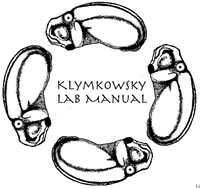| Immunoblot
protocol:
- After electrophoresis, cut
away teeth of stacking gel and cut gel for staining and blotting --
minigels are 6 x 8 cm .
- Place gel in 20% methanol:
running buffer:0.01% SDS and wet blotting
paper and nitrocellulose paper.
- if you are using immobilon
P -- you have to wet it with 100% methanol - be careful methanol
will dissolve nitrocellulose.
- Set up blot cassette - blot
at 100V constant volts for 1h or more (1 h should be more than enough
however.
- Block
blot: 5% low fat dried milk in TBS-Tween(LFDM-TBST) for 15-60 minutes.
TBS-Tween: 200mM NaCl / 50mM Tris-HCl pH7.4 0.5% Tween
- incubate with first antibody,
o/n at r.t. or 4°C in 20% calf serum or in LFDM-TBST.
Ponceau staining of nitrocellulose protocol
Take
care to titre antibodies: primary antibodies should be
used 1:1000 to 1:10,000 and secondary antibodies between 1:10,000 to 1:40,000.
- wash 3 x 10 minutes each
TBS-Tween
- incubate 1-2h in secondary
antibody
- wash as above.
- After final washing, mix
up ECL reagent (1:1) and incubate with blots for 5 min. typically it
takes 2 to 3 ml to cover 1 to 2 minigel blot equivalents.
- pour off the reagent --
seal the bag and expose (protein side up) to X-ray film (XAR5 is fine)
-- first test 30 seconds and 5 minutes - develop film
- You can do other exposures
if this does not capture the data you need (reaction is stable for about
24 hours).
|

